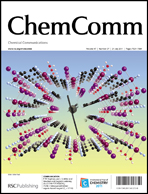Confirmation of the classic tris(2,2′-bipyridyl)ruthenium(ii) and oxalate electrochemiluminescence mechanism using EPR spectroscopy†
Abstract
A chemically initiated adaptation of the classic [Ru(bipy)3]2+/oxalate electrochemiluminescence coreactant system has revealed the elusive radical intermediates of the light-producing pathway.


 Please wait while we load your content...
Please wait while we load your content...